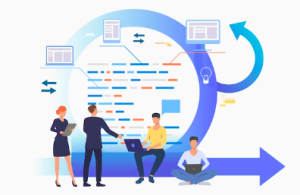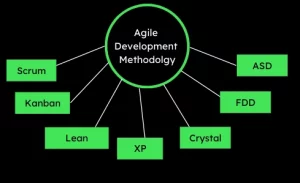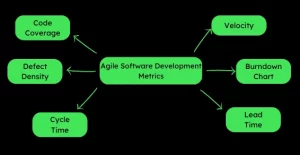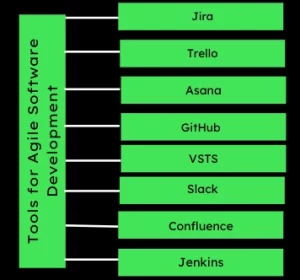What is Agile Software Development?
Agile software development is an approach to creating software that emphasizes flexibility, collaboration, and customer satisfaction.
In Agile, development teams work in short iterations or cycles, typically two to four weeks long, called sprints. During each sprint, the group focuses on building and delivering a small, functional piece of the software.
Let us dive in to understand agile software development.
What is Agile Software Development?
Agile software development is a methodology for software development that emphasizes flexibility and collaboration. It prioritizes delivering minor, incremental improvements to a software product over a short period rather than trying to deliver a complete product all at once.

The Agile approach values customer collaboration, responding to change, and providing working software frequently. It is based on the Agile Manifesto, which outlines 12 principles for software development that prioritize collaboration, customer satisfaction, and flexibility over processes and tools.
The most popular Agile methodologies include Scrum, Kanban, and Lean.
Key Features of Agile Software Development
The key features of Agile software development include:
- Iterative and incremental delivery: Agile development focuses on delivering small, working portions of a software product in frequent, iterative cycles.
- Customer involvement: Agile development strongly emphasizes involving the customer or end-user throughout the development process to ensure that the built software meets their needs.
- Flexibility: Agile development prioritizes the ability to respond to change and adapt to new requirements or shifts in project direction.
- Collaboration: Agile development encourages collaboration among team members, including developers, business stakeholders, and customers.
- Working software as the primary measure of progress: In Agile development, the most crucial step of success is delivering working software rather than just documentation or completion of specific project milestones.
- Self-organizing teams: Agile development empowers teams to self-organize and decide how best to complete their work.
- Continuous improvement: Agile development values continuous improvement and encourages teams to reflect on their processes and make changes to become more efficient and effective.
Stats of Agile Software Development
The fastest growth rate across all company categories is undoubtedly in the software development sector. It goes without saying that trends are changing as quickly as the industry, and it is crucial for organizations and their development teams to stay on top of them.
Some industry insights about agile development include:
- As per the 2020 State of Agile report, 94% of organisations have implemented Agile in one way or another, and 70% claim to use Agile as their primary method for developing software.
- According to the same report, organizations that use Agile methods have a higher success rate when reporting project outcomes; only 32% of traditional projects are reported as successful, whereas 60% of Agile projects are.
- According to a CollabNet study, workers in Agile environments are likelier to be happy in their jobs; 83% of Agile workers reported being highly satisfied, compared to only 72% of workers in traditional settings.
Some other details about software development that is important for agile software development include:
To fill the industry gaps and requirements:
- We already have 26.9 million software developers in the world. (Truelist)
- The most-used software development management tool is Jira. (The Codest)
- The most popular framework used by software engineer is React.js (Statista)
The whopping demand can be met by skilled and passionate developers.
Next let us read about Agile Software Development Cycle.
What Is Agile Software Development Life Cycle?
The Agile software development process, also known as an iteration or sprint, typically follows these steps:
Planning: The team determines what features or components of the software they want to build during the upcoming iteration.
Design and development: The team designs and builds the software, following Agile principles such as customer collaboration and working software as the primary measure of progress.
Testing: The team tests the software to ensure it meets the agreed-upon requirements and specifications.
Review and demo: The team demonstrates the newly built software to stakeholders and receives feedback.
Retrospective: The team reflects on the iteration, identifying what worked well and what can be improved for the next iteration.
Repeat: The cycle then repeats, with the team using the feedback from the review and demo to plan and build the next iteration of the software.
This cycle is repeated until the software is fully functional and meets customer or end-user needs. Focusing on frequent, small deliveries allows the team to quickly respond to changes in requirements or direction and to ensure that the built software is high quality and meets the customer’s needs.
What Are The Values And Principles Of The Agile Manifesto?
The Agile Manifesto outlines four values and twelve principles for software development:
Values:
- Individuals and interactions over processes and tools
- Working software over comprehensive documentation
- Customer collaboration over contract negotiation
- Responding to change by following a plan
Principles:
- Our highest priority is to satisfy the customer through the early and continuous delivery of valuable software.
- Welcome change, even late in development. Agile processes harness change for the customer’s competitive advantage.
- Deliver working software frequently, with a preference for shorter timescales.
- Business people and developers must work together daily throughout the project.
- Build projects around motivated individuals.
- The most efficient and effective method of conveying information to and within a development team is by face-to-face conversation.
- Working software is the primary measure of progress.
- Agile processes promote sustainable development. The sponsors, developers, and users should be able to maintain a constant pace indefinitely.
- Continuous attention to technical excellence and good design enhances agility.
- Simplicity–the art of maximizing the amount of work not done–is essential.
- The best architectures, requirements, and designs emerge from self-organizing teams.
- The team regularly reflects on how to become more effective, then tunes and adjusts its behavior accordingly.
Agile Software Development Methods
There are several types of Agile methodologies, each with its own unique approach and focus. Some of the most popular Agile methodologies include:

Scrum:
A popular Agile methodology that focuses on delivering software in short iterations, known as sprints, and emphasizes collaboration and continuous improvement.
Kanban:
methodology that uses visual boards to track the flow of work and prioritize tasks. Kanban prioritizes flexibility and adapting to change.
Lean:
An Agile methodology that is based on the principles of Lean manufacturing and focuses on reducing waste and maximizing value.
Extreme Programming (XP):
A methodology that emphasizes technical practices such as test-driven development, continuous integration, and pair programming.
Crystal:
A family of Agile methodologies that are tailored to specific project needs, such as large projects or projects with regulatory requirements.
Feature-Driven Development (FDD):
A methodology that focuses on delivering a series of functional features and components in short cycles.
Adaptive Software Development (ASD):
A methodology that emphasizes flexibility and adapting to change, using Agile principles and practices to guide development.
These are just a few of the many Agile methodologies that have been developed. Teams can choose the methodology that best fits their needs and project requirements.
Agile Software Development Metrics
Agile software development metrics measure the progress and success of a project that follows the Agile methodology. Here are some common metrics used in Agile software development:

- Velocity – This metric measures how much work a team can complete within a sprint. It’s calculated by adding the number of story points completed in a sprint.
- Burndown Chart – This chart shows how much work is left to do in a sprint and how much time remains. It helps the team stay on track and adjust their approach as needed.
- Lead Time – This metric measures the time a new feature takes from ideation to production. Lead Time enables teams to identify issues in their development process and improve efficiency.
- Cycle Time – This metric identifies the time taken by a task or feature to move through the development process, from beginning to end. It helps teams identify areas for improvement and optimize their workflow.
- Defect Density – This metric measures the number of defects in the code per unit of work completed. It helps teams identify areas where quality can be improved.
- Code Coverage – This metric measures the percentage of code covered by automated tests. It helps teams ensure their code is thoroughly tested and minimizes the risk of bugs and defects.
Advantages And Disadvantages Of Agile
Advantages of Agile:
Faster time to market:
Agile development allows teams to deliver working software faster, helping organizations market their products and services more quickly.
Increased customer satisfaction:
Agile development emphasizes involving the customer throughout the development process, ensuring that the software being built meets their needs.
Better quality software:
Agile development emphasizes frequent, small deliveries and continuous testing, helping to catch and fix defects early and improving the overall quality of the software.
Improved collaboration and communication:
Agile development encourages cooperation and communication among team members, fostering a sense of shared ownership and helping ensure everyone is working towards the same goals.
Increased adaptability:
Agile development values flexibility and the ability to respond to change, making it easier for organizations to adapt to shifting requirements or market conditions.
Disadvantages of Agile:
Lack of upfront planning:
Agile development may only sometimes provide enough upfront planning, leading to unclear project goals and requirements.
Difficulties with stakeholder management:
Agile development requires active involvement from stakeholders, which may be challenging for some organizations to achieve.
Lack of structure:
Agile development may need more structure and discipline, leading to clarity and a lack of accountability.
Resource constraints:
Agile development may require more resources, including time, money, and manpower, than traditional software development methods.
Difficulties with long-term planning:
Agile development may make it difficult to plan and manage long-term projects, as the focus is on delivering working software in short iterations.
How to Implement Agile Software Development?
Implementing Agile software development requires a commitment to Agile values and principles and a willingness to change existing processes and ways of working. Here are some steps to help you implement Agile software development:
-
Create a cross-functional team:
Agile development requires a group that includes representatives from all areas of the organization, including developers, business stakeholders, and testers.
-
Choose an Agile methodology:
Identify an Agile method that aligns with your organization’s goals and values and fits your project’s needs.
-
Define your product backlog:
Create a prioritized list of the features and requirements for your software, known as the product backlog.
-
Plan and prioritize work:
Use the product backlog to plan and prioritize the work that needs to be done, using techniques like story mapping or agile estimation.
-
Implement an Agile workflow:
You can use any Agile workflow, such as Scrum or Kanban, to manage your team’s work and ensure that everyone is working towards the same goals.
-
Emphasize collaboration and communication:
Foster a culture of collaboration and communication, encouraging team members to collaborate and share information.
-
Implement Agile practices:
Ensure quality software development by implementing Agile practices, such as continuous integration, test-driven development, and pair programming.
-
Regularly reflect and improve:
Seeking feedback from team members and stakeholders. Better to make changes to improve your operations well in time.
Popular Tools Used In Agile Software Development
Many tools are available to support Agile software development, including project management tools, collaboration tools, and tools to help specific Agile practices. Here are some popular tools used in Agile software development:

Jira:
- An Agile team’s go-to project management tool for planning sprints and keeping track of work.Popular project management software Jira is a good fit for agile software development. Jira is useful for this kind of development because of a few characteristics, which include the following:
- Agile boards: Jira makes it simple for teams to arrange and rank tasks by providing pre-made boards for the Scrum and Kanban approaches.
- Workflows that are customizable: Jira enables you to design processes that correspond with your unique development process, simplifying the task management and progress monitoring processes.
- Real-time reporting: Jira provides you with dashboard views and real-time reporting to enable you to monitor the status of your tasks and projects.
- Integration with other tools: Jira can be integrated with many development tools, including platforms for continuous integration and continuous deployment (CI/CD), issue trackers, and code repositories.
- Additionally, Jira provides teams with a mobile app to collaborate and communicate without being confined to their desks.
- Jira also offers a mobile app that enables teams to manage and stay in touch with each other while not seated at their desks.
- Features for collaboration: Jira facilitates teamwork by enabling comments, notifications, and mentions, which make it simple for groups to interact and collaborate efficiently.
Trello:
Trello is a popular tool that allows teams to manage tasks and projects. It deploys using a Kanban-style board. Some of the features of Trello are:
- Kanban boards: Trello allows you to create boards and cards to represent tasks and projects, using a visual, Kanban-style approach to organization and prioritization.
- Boards that can be customized: Trello provides a great deal of customization options, such as the ability to add labels, deadlines, checklists, and card attachments.
- Features for collaboration: Trello offers a number of tools for collaboration, such as the ability to assign tasks to team members and annotate, mention, and comment on cards.
- Integrations: Trello makes it simple to keep all of your development tools in one location by integrating with a variety of services and tools, such as chat apps, issue trackers, and code repositories.
- Mobile app: Trello also offers a mobile app that enables teams to manage tasks and remain in contact even when not seated at their desks.
- Simplicity: Trello’s user-friendly design makes it suitable for teams of all sizes and abilities, negating the need for complicated setup or training.
Asana:
Let us read about Asana:
- Comprehensive Project Management Tool: Asana is an integrated platform for teams to monitor and efficiently handle tasks, projects, and collaboration.
- Agile Software Development Compatibility: Tailored for agile software development, Asana supports methodologies like Scrum and Kanban.
- Task Management: Asana enables the creation of tasks, organizes their organization into projects, and tracks progress through diverse visualization tools and reporting features.
- Collaboration Features: With comments, mentions, and task assignments, Asana facilitates seamless team collaboration.
- Integrations: Asana seamlessly integrates with various tools and services, including code repositories, issue trackers, and chat apps, consolidating all development tools in one accessible location.
- Mobile Accessibility: The inclusion of a mobile app ensures teams can stay connected and manage tasks on the go, enhancing flexibility and responsiveness.
- Customization Options: Asana offers various customization choices, allowing users to create custom fields, add tags and statuses, and establish tailored workflows to align with specific development processes.
GitHub:
GitHub is a widely utilized web-based platform by Agile development teams for managing code and tracking changes.
- Version Control System: GitHub employs a distributed version control system based on Git, simplifying code management and collaboration for teams.
- Pull Requests: GitHub facilitates pull requests, allowing teams to review, discuss, and merge code changes in a controlled and transparent manner.
- Code Review Tools: GitHub provides tools for efficient code review, enabling teams to collaborate on code changes and offer feedback on code quality and maintainability.
- CI/CD Integration: GitHub seamlessly integrates with various CI/CD tools, streamlining the automation of the build, test, and deployment processes for applications.
- Project Management: GitHub encompasses features like issue tracking, project management, and wikis, simplifying the monitoring of bugs, feature requests, and other development tasks.
- Open Source Collaboration: Widely adopted for open-source projects, GitHub facilitates easy contribution to and reuse of existing code, fostering collaboration and benefiting from the assistance of others.
Slack:
Slack is a widely used tool enabling teams to communicate, share files, and collaborate in real-time.
- Real-Time Communication: Offering real-time messaging and file sharing, Slack facilitates instantaneous team communication and collaboration.
- Tool Integration: Slack seamlessly integrates with various tools and services, including code repositories, issue trackers, and project management tools, consolidating all development tools in one accessible location.
- Customizable Notifications: Users can tailor notifications on Slack to stay updated on events and updates pertinent to them.
- Mobile Accessibility: With a mobile app, Slack ensures teams can stay connected and manage communication even when away from their desks.
- Channels for Organization: Slack provides channels for organizing communication-based on topics or projects, enhancing the ability to locate and monitor relevant conversations.
- Collaboration Features: Supporting collaboration through features like comments, mentions, and reactions, Slack makes it simple for teams to communicate and effectively work together.
Confluence:
Confluence is a widely utilized platform for team collaboration and knowledge management, favored by many Agile teams for sharing information and documenting processes.
- Centralized Collaboration Platform: Confluence offers a centralized platform for teams to share documents, ideas, and knowledge collaboratively.
- Wiki-Style Content Creation: Supporting the creation of wiki-style pages, Confluence simplifies the process of generating, organizing, and sharing information and knowledge.
- Page Templates: Confluence provides page templates, streamlining content standardization and structure, thereby reducing the time and effort required for creating new pages.
- Customizable Permissions: With Confluence, you can control access to and edit permissions for content, facilitating the management of sensitive information.
- Integrations: Confluence seamlessly integrates with various tools and services, including code repositories, issue trackers, and project management tools, ensuring the consolidation of all development tools in one accessible location.
- Version Control: Offering version control for pages and attachments, Confluence facilitates easy tracking of changes and allows users to revert to previous versions if necessary.
Visual Studio Team Services (VSTS):
Visual Studio Team Services (VSTS) is a collection of development tools offered by Microsoft encompassing version control, testing, and project management.
- Cloud-Based Software Development Platform: VSTS is a cloud-based platform designed for software development, offering a comprehensive set of tools and services tailored to support agile development practices.
- Agile Planning and Tracking: VSTS provides various tools and templates, including backlogs, sprints, and boards, to facilitate agile planning and tracking.
- Continuous Integration and Deployment (CI/CD): VSTS features CI/CD pipelines, automating the build, test, and deployment processes for applications.
- Code Review and Feedback: VSTS includes code review and feedback tools, simplifying collaboration on code changes and providing insights into code quality and maintainability.
- Source Control Options: VSTS offers both Git and TFVC source control options, streamlining code management and collaboration for teams.
- Work Item Tracking: VSTS provides work item tracking functionality, covering aspects such as bugs, features, and user stories, facilitating easy monitoring of development tasks.
- Integrations: VSTS seamlessly integrates with various tools and services, including code repositories, issue trackers, and project management tools, consolidating all development tools within a unified platform.
Jenkins:
Jenkins, an open-source tool, is widely used by Agile teams to automate software builds, testing, and deployments to support continuous integration in Agile software development.
- Easy Setup and Configuration: Jenkins stands out for its simplicity in installation, configuration, and project setup.
- Extensive Plugin Library: Jenkins boasts a vast library of plugins and extensions that support a wide range of tools and technologies.
- Automated Builds: Developers can utilize Jenkins to automate the build and test processes, reducing the time spent on manual tasks.
- Streamlined Continuous Integration: Jenkins provides a simplified approach to continuous integration, aiding in the early identification and resolution of conflicts and bugs in the development process.
- Customizable Pipeline: Jenkins offers a highly customizable pipeline, allowing developers to create a tailored workflow that aligns with their needs.
- Distributed Builds: Jenkins supports distributed builds, enabling teams to scale their CI/CD environment and ensure faster completion of forms.
- Comprehensive Reporting and Analytics: Jenkins provides robust reporting and analytics features, enabling teams to track and analyze build results, test outcomes, and code coverage metrics.
The use of the right tool depends on the needs of your team and the specific practices and processes you are using.
Common Agile Metrics
Agile metrics track the progress and performance of Agile development projects.
Here are some standard Agile metrics:
Sprint velocity: Measures the average amount of work completed by a team in a sprint, used to predict future performance and to measure team productivity.
Burn-down chart: A visual representation of work remaining in a sprint or project, used to track progress and identify potential roadblocks.
Lead time: Measures the time it takes for a user story to go from idea to delivery, used to measure the overall efficiency of the development process.
Cycle time: Measures the time it takes for a task to be completed, from start to finish, used to identify issues to optimise processes.
Defect density: Measures the number of defects per unit of code, used to track software quality and identify improvement areas.
Test coverage: Measures the percentage of code tested to track the quality of software and ensure that all code is thoroughly tested.
Customer satisfaction: Measures customer satisfaction with the software and the development process, used to identify improvement areas and ensure that customer needs are being met.
These are just a few examples of Agile metrics that can be used to track the performance and progress of Agile development projects. Of course, the right metrics depend on the needs of your project and the goals you are trying to achieve.
Also Read : What is the Software Development Life Cycle?
Final Word
Agile software development is a collaborative, iterative approach to software development that emphasizes flexibility, adaptability, and continuous improvement. By valuing individuals and interactions, working software, customer collaboration, and responding to change, Agile development helps organisations deliver high-quality software quickly and efficiently.
If you are looking for an agile software development, you can connect with us.
FAQ’s
What Is Meant By Agile Software Development?
Agile software development is a project management approach that values flexibility, collaboration, and customer satisfaction. It focuses on delivering software in small, iterative cycles rather than trying to deliver a complete product all at once.
Agile software development emphasises continuous improvement, communication, and adaptability to change.
What is an Agile Software Development example?
An example of Agile software development is a team building a new mobile application for a customer. The group begins by working with the customer to understand their requirements and to prioritize the features that are most important to them.
The team then breaks the project into smaller, manageable chunks called “sprints.” The group focuses on delivering a specific set of features during each sprint. After each sprint, the team demonstrates their work to the customer and receives feedback.
The unit uses this feedback to make software changes and plan the next sprint. This iterative process continues until the final product is delivered.
Throughout the project, the team stays in close communication with the customer and can respond quickly to customer requirements changes.
This flexible, adaptive approach helps the team deliver high-quality software that meets the customer’s needs while allowing the team to continuously improve their processes and the software they are developing.
What Are The 5 Phases Of Agile Software Development?
The 5 phases of Agile software development are:
- Envision: This phase is about defining the project, determining the project goals and objectives, and creating a high-level view of the product.
- Speculate: This phase defines the requirements and breaks the product into smaller, manageable chunks called “user stories.”
- Explore: This phase involves designing and prototyping the product and testing the design to ensure it meets the requirements.
- Adapt: This phase is about building and testing the product and making any necessary changes based on feedback from stakeholders and customers.
- Close: This phase is about delivering the final product, closing out the project, and conducting a post-implementation review to determine what worked well and could be improved for future projects.



